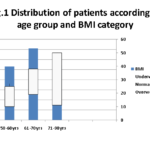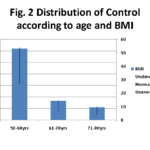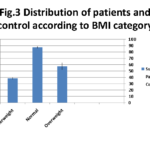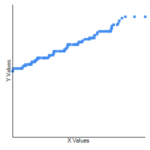J Med Discov (2018); 4(1):jmd18052; DOI:10.24262/jmd.4.1.18052; Received September 29th, 2018, Revised January 22nd, 2019, Accepted January 30th, 2019, Published February 11st, 2019.
There is no correlation between BMI and clinical BPH- a hospital based case control study in Enayetpur, Bangladesh
Ashraf Uddin Mallik1, Mostafizur Rahman2, Uttam Karmakar3, Baikaly e Ferdous4, Haniara Khatun5, Tamanna Jahan6
1Prof. and Head of Urology,Department of Urology, Khwaja Yunus Ali Medical College and Hospital, Enayetpur, Sirajganj, Bangladesh. E-mail- ashrafmallik143@gmail.com
2Assistant Prof. and Laparoscopicand Reconstructivesurgeon ofUrology,Department of Urology, Khwaja Yunus Ali Medical College and Hospital, Enayetpur, Sirajganj, Bangladesh.
3Associate Prof. of Urology, Dhaka Medical College and Hospital,Dhaka.
4Registrar,Department of Urology, Khwaja Yunus Ali Medical College and Hospital, Enayetpur, Sirajganj, Bangladesh.
5Assistant Registrar,Department of Urology, Khwaja Yunus Ali Medical College and Hospital, Enayetpur, Sirajganj, Bangladesh.
6Medical Officer, Department of Urology, Khwaja Yunus Ali Medical College and Hospital, Enayetpur, Sirajganj, Bangladesh.
* Correspondence: Ashraf Uddin Mallik. Prof. and Head of Urology,Department of Urology, Khwaja Yunus Ali Medical College and Hospital, Enayetpur, Sirajganj, Bangladesh. E-mail-ashrafmallik143@gmail.com
Abstract
Background: Benign Prostatic Hyperplasia (BPH) is the most commonly diagnosed benign adenoma which causes serious clinical symptoms by bladder outlet obstruction. BPH patients suffer from negative changes in their quality of life and restriction of their daily activities due to the disease symptoms. Our main objectives in this study are to evaluate the relationship between body mass index (BMI) and BPH.
Materials and Methods: This is a prospective study done from October 2015 to November 2017, in the department of Urology, KYAMCH, Enayetpur, Bangladesh. We included 178 patients, who came to urology outpatient department(OPD) for their BPH symptoms and recruited 180 subjects as control, who came to urology OPD other than urinary problems. Age ranged from 50 to 90 years both for patients and control. All patients in this study were subjected to a standardize diagnostic panel which included physical examination, biochemistry panels, urinalysis, histopathology report after transurethral resection of the prostate(TURP), prostatectomy and prostate biopsy for carcinoma prostate.
Results: The mean age of the patients and control was found to be 66.89 years and 59.59 years respectively. A majority of the patients(40%) were in the age group of 61 to 70 years. Out of 100 patients, 48 had in healthy BMI, while 29 had an overweight and 22 had an underweight BMI (table 1). Among the parameters, which were obtained by stratification of age and BMI, the number of normal BMI patients were found to be the most representative of BPH, showing no correlation with underweight or overweight BMI.
Conclusion: Through our study, we might not find any correlation between increase BMI and BPH.
Keywords: Body Mass Index, Benign Enlargement of Prostate, case-control study.
Introduction
Lower urinary tract symptoms(LUTS) suggestive of benign prostatic hyperplasia (BPH) are the most common benign urological condition of the prostate occurring in middle aged and elderly population[1]. Enlargement of the prostate gland and subsequently narrowing of the urethra are characterized by overgrowth of the transitional and periurethral area of the prostate resulting from proliferation of stromal and glandular elements. Primary manifestation of BPH is LUTS, making disorders of bladder storage or emptying. About 50% of men over 50 years of age and 80% of those over 80 years old are affected with BPH[2]. BPH is a complex disease that is progressive in many men, commonly associated with symptoms ;it can also result in complications causing low quality of life[3,4]. For reduction of burden of BPH symptoms proper identification of potentially modifiable factors is necessary. Recently, attention has been focused on diet, exercise, lifestyle and metabolic disturbances as risk factors for BPH[5,6] . BMI and few metabolic diseases have long been hypothesized to influence the risk of prostate hyperplasia , although many published epidemiological evidence demonstrated that obesity such as increase BMI may increase the risk of LUTS suggestive of BPH[7-10].
Etiopathogenesis of BPH is unclear. Many predisposing factors are mentioned for the development of this illness. During the advancement of age, decrease androgen and testosterone and increase of estrogen level both are responsible for BPH development[7]. Another cause is the increase proliferation of fibromuscular gland, insulin like growth factor activity are responsible for prostatic hyperplasia[8-10].
Obesity is a medical condition in which excess body fat accumulates to the extent that it may have a negative effect on health. Hippocrates wrote “Corpulence is not only a disease itself, but the harbinger of others”. Obesity increases the likelihood of various diseases and conditions, particularly cardiovascular disease, type 2 diabetes, cancer, osteoarthritis, depression causing decreased quality of life. It is a common problem among ageing men. Studies showed that over a half of men have problems maintaining the proper body mass tendency which increases with age[11].
Many studies showed the correlation between BMI and BPH. According to estimations when the BMI rises by 1 kg/m 2,the prostatemass is increased by 0.45 gm on an average[12-14].There are many conflicting reports regarding association between BMI and BPH. Some studies have shown that metabolic diseases and obesity have a high risk of BPH[7]. Some studies have shown that they did not find any association between BMI and BPH [15,16]. So, the association between BMI and BPH in men has yet to be investigated.
Materials and Methods
The objectives of the present study are as follows. Primary objective: To study the correlation between BMI and symptomatic BPH Patients.
Secondary objectives:
- To determine the age group that is most affected by BPH.
- To determine the category of BMI which affects most BPH.
- To find any difference between age groups of patients and control.
- To find any difference between the 3 BMI categories of patients and control.
Materials
Study design: Prospective study.
Duration of study : Two years from October 2015 to November 2017.
Setting: Urology Department, KYAMCH, Enayetpur, Bangladesh.
Sampling technique: Consecutive patients. Sample size : 178 patients and 180 control.
Ethical Clearance : Ethical clearance letter was obtained from the Institutional Ethical Review Board (IERB)
Inclusion criteria: Patients of clinical BPH presenting with lower urinary tract symptoms (LUTS) in the age group of 50 and above.
Exclusion criteria:
- Patients who had indwelling Foley`s catheter,
- Patients who had undergone prior urinary tract or pelvic surgeries.
- Patients who had past history of prostate surgery, prostate carcinoma, urethral stricture,
vesical calculus or neurogenic bladder.
- Patients who had systemic disorders that can influence bladder function such as neurological disorders.
- Patients who voids urine less than 150 ml.
- Patients who did not give consent.
Methods
All patients of clinical BPH visiting urology OPD, fulfilling inclusion criteria, were included in this study. These patients were evaluated by standardized diagnostic panel which included physical examination, biochemistry study, urinalysis, histopathology report after transurethral resection of prostate (TURP), after prostatectomy, prostate biopsy for carcinoma prostate . All the parameters obtained from patients and control were documented by doctors. Statistical analysis : The data were entered, cleaned and coded in Microsoft excel. The data were then analyzed through SPSS, version 16. Pearson’s correlation formula was used for correlation, chi-square test and ANOVA test were used for comparison where p-value was considered significant if <0.05.
Table 1. Demographic data of patients and control
| Patients | Control | |
| Total number | 178 | 180 |
| Mean age | 66.89+/- 9.28 SD | 59.59+/-8.96 SD |
| 95% Confidence Interval (CI) | 65.53 | 58.21+/-8.96 SD |
| Mean BMI (kg/m 2 ) | 21.18+/- 3.57 SD | 21.78+/-3.97 SD |
| 95% Confidence Interval (CI) | 20.66 | 21.17 |
| Under weight | 40 pts.(22%) | 37 pts. (21%) |
| Normal BMI | 86 pts (48%) | 81 pts.(45%) |
| Overweight or Obese | 52 pts.(29%) | 62 pts.(34%) |
Unpaired t-testp=0.001(age)
Results
The BMI of patients and control were divided in categories according to WHOBMI classification of Asia Pacific : underweight if BMI< 18.50 kg/m2 ; normal weight (healthy) if BMI = 18.50- 22.9 kg/m 2;overweightif BMIover 22.9 kg/m 2 .The demographic data of patients and control were shown in table 1. The mean age of patients and control was found 66.89 +/-9.28 SD and 59.59 +/- 8.96 SD respectively. The mean BMI of patients and control was 21.18 +/-3.57 SD and 21.78 +/-3.97 SD respectively. Out of100 patients,48 were in normal (healthy) BMI , 29 were in overweightand 22 were in underweight BMI . The number of patients in normal BMI was higher than those ofunderweight or overweight. Our result showed that the incidence of BPH patients is not related to BMI, rather age related. The same picture was found in case of control (table 1). Figure 1 showedthe patients` distribution according to age groups and BMI categories, in which a higher number of patients were in normal BMI in 3 age groups. Even higher number of patients suffered from BPH in group B and C compared with group A. Figure 2 indicates the distribution of control according to age group and BMI categories. In control, a higher number was in group A in normal BMI category, which indicates BPH is age-related compared with group B and C. When patients and control were categorized according to different BMI category, a higher number of patients were affected by BPH in normal BMI (Fig. 3). We could not find any correlation between BMI and BPH when the distribution of patients and control group was analyzed according to BMI category.
Pearson`s correlation formula applied to find out age and BMI correlation showed that there was strong positive correlation (p<0.00001)( r=0.9931). Figure 4 showed statistical analysis of patients` BMI in different BMI categories. Mean BMI of overweight patients was 25.67 kg/m 2, which is more than that of normal BMI or overweight or underweight. But the incidence of BPH is more in normal BMI. Statistical analysis of patients in different BMI categories shown in tableFinding suggests that incidence of BPH may not be related with BMI.
Table 2. Statistical analysis of patients in different BMI categories
| BMI categories | Mean BMI | Standard deviation(SD) | Population SD | 95% Confidence Interval (CI) |
| Normal BMI (86pts) | 20.55 | 1.32 | 1.72 | 20.55 |
| Overweight (52 pts) | 25.67 | 1.95 | 1.93 | 25.67 |
| Under weight(40 pts) | 16.74 | 1.03 | 1.02 | 16.74 |
Discussion
In this case-control study elevated BMI could increase the risk of BPH. But we did not notice any such increased risk. Thus our results may not reflect the trend toward increase risk of BPH with increase BMI.The etiology of BPH remains still largely unresolved, as both multiple, partially overlapping and complementary systems(i.e. nervous, endocrine, immune and vascular system) and local factors are likely to be involved[17].
We could not find any association between BMI and BPH, rather found a difference in patients` number which is age related (table 2).Obesity has been hypothesized to be associated with BPH because of the endocrine changes in men that occur with age. It has been found that obesity is more prevalent among men with BPH than in men without BPH as obesity is also related with metabolic syndrome and vice versa[18].
Abdominal obesity increases the estrogen to androgen ratio and subsequently mayincrease sympathetic nervous activity, which increase the risk of BPH. It also increases the chance of inflammation and the extent and severity of the inflammation correspond to the prostate enlargement. It is proved that obesity promotes microvascular disease and inflammation, which inter contribute to ischemia, oxidative stress and an intraprostatic environment favorable toBPH[19-20]. In our analysis, yielded null results in most subgroups. It should still be interpreted with caution considering the limited number of studies. The null results could be due to an inadequate number of cases to detect the strength of the postulated associations. There may exist a possibility that the complex etiology of BPH, which included genetic susceptibility, culture and lifestyles, would probably mask the positive association, whereas in our analysis, we could not provide optimum information. But a positive relationship between BMI and risk of BPH was observed in healthy BMI patients. This difference may, in part, be due to differences in diet, environment and ethnic background in this region.
Fig.4 Pearson`s correlation of Age and BMI of patients(R=0.9931,p<.00001, the result is significant at p<0.05). strongly positive correlated . X=BMI, Y=age.
The results of our study with other studies were heterogeneous, reflecting differences among study patients, model selection, analytic methodology, exposure assessment and operational definition of BPH[7,12]. Our results from subgroup analysis also could not demonstrate any association. The discrepancy between our results and others might be attributed to our selection of patients seeking urological treatment from the OPD.
Overall current literature suggests significant association on the risk of BPH and obesity[21]. Further exploration of case control study indicated that BMI could increase risk of BPH. However, when the including studies were stratified by study design ,geographical region and primary outcome, most of the subgroups shows BMI is not associated with BPH. Larger prospective studies are needed to confirm increase BMI and BPH relationship.
Conflict of interest
Increase BMI and BPH represent entirely separate disorders and their incidence is age related. In different journals , articles published suggested that increase BMI may increase the risk of BPH. However, association reported in published literatures is conflicting. As the specific etiological factors of BPH occurrence and gradually progression is yet unknown, we did not find any correlation between BMI and BPH.
The results obtained suggest that there is further need for analysis and research on the impact of obesity on the etiology and course of BPH. More case-control, metabolic, genetic and observational studies are needed to confirm the hypothesis and explanation of having any genetic disorder.
Conflict of interest
None
Acknowledgments
We acknowledgeProfessor AHM Abual Islam, head of English Dept. Khwaja Yunus AliUniversity for making correction of English spelling of themanuscript.
References
1.Abdullah BA, Anfal MA,Omar AA,Munif SA, et al. Epidemiology of senile prostatic enlargement among elderly men in Arar, Kingdom of Saudi Arabia. Electron Physician. 2017 ; 9(9): 5349-5353.
2.Park J,Lee YJ,Lee JW,Yook TK,Chung JI,Yun SJ et al. Comparative analysis of Benign ProstaticHyperplasia management by Urologist and nonurologists : A Korean nationalwide health insurance database study. Korean J Urol 2015; 56:233-9.
3.Reginald C,Bruskewitz MD.Quality of life and sexual function in patients with Benign Prostatic hyperplasia. Rev Urol.2003;3(2):72-80.
4. Speakman M, Kirby R,Doyle S,Ioannou C. Burden of male lower urinary tract symptoms(LUTS) suggestive of benign prostatic hyperplasia(BPH)- focus on the UK.BJU Int. 2015;115(4):508-19.
5.Parsons JK. Life style factors, benign prostatic hyperplasia and lower urinary tract symptoms. Curr Opin Urol. 2011;21(1):1-4.
6.Moyad MA. Life style changes to prevent BPH : heart healthy=prostate healthy. Urol Nurs. 2003;23(6):439-41.
7.Parsons JK,Carter HB,Partin AW,Windham BG,Metter EJ,Ferrucci L. Metabolic Factors associated with benign prostatic hyperfplsia.J Clin Endocrinol Metab. 2006;91:2562-2568.
8.Chokkalingam AP, Gao YT,Deng J,Stanczyk FZ,Sesterhenn IA et al. Insulin-like growth factors and rise of benign prostatic hyperplasia. Prostate.2002;52(2):98-105.
9.Mantzoros CS,Tzonou A,Signorello LB,Stampfer M,Trichopoulos D, AdamiHO. Insulin –like growth factor 1 in relation to prostate cancer and benign prostatic hyperplasia. Br J Cancer. 1997;76(9):1115-8.
10.Wang Z, Olumi AF. Diabetes , growthhormone-insulin-like growth factor pathways andassociation to benign prostatic hyperplasia. Differentiation. 2011; 82(4-5):261-71.
11.Shilpa A,Kalyani S,Manisha S.Health consequences of obesity in the elderly. J Clinical Gerontology and Geriatrics. 2014; 5(3): 63-67.12.Kok ET,Schouten BW,Bohnen AM, Groeneveld FP, Thomas B, Bosch JL. Risk factors for lower urinary tract symptoms suggestive of benign prostatic hyperplasia in a community based population of healthy aging men: the krimpen study. J Urol. 2009;181:710-716.
13.Ozden C,Ozdal OL,Urgancioglu G,Koyuncu H,Gokkaya S,Memis A. The correlation between metabolic syndrome and prostatic growth in patients with benign prostatic hyperplasia. Eur Urol. 2007;51(1):199-203.
14.Lee SH,Kim JC,Lee JY,Kim JH, Oh CY, Lee SW, Yoo SJ,Chung BH. Effects of obesity on lower urinary tract symptoms in Korean BPH patients. Asian J Androl. 2009;11(6):663-8.
15.Ryl A,Rotter I,Grabowska M, Slojeweki M,Laszczynska M. The impact of BMI and other sociodemographic factors on the intensification of prostatic hyperplasia symptoms in the group of affected patients. J Public Health, Nursing and medical rescue. 2014;3:70-75.
16.Prezioso D,Catnogno C,Galassi P, D`Androea G, Castello G, Pirritano D. Life- style in patients with LUTS suggestiveof BPH. Eur Urol. 2001;40(suppl 1):9-12.
17.Jie T, and Jingchun Y. Etiopathogenesis of benign prostatic hyperplasia. Indian J Urol. 2009;25(3):312-317.
18.Jae HJ, Song VA, Jae MS,Se-Jim C et al. Obesity as a risk factor for prostatic enlargement: A retrospective Cohort study in Korea. Int Neurourol J. 2016;20(4):321-328.
19.Lee RK,Chung D,Chugtai B,Te AE, Kaplan SA. Central obesity as a measured by waist circumference is predictive of severity of lower urinary tract symptoms. BJU Int. 2012; 110:540-545.
20.Parsons JK,Carter HB,Partin AW,Windham BG,Mefter EJ,Ferrucci L. Metabolic factors associated with benign prostatic hyperplasia. J Clin Endocrinol/Metab. 2006;91:2562-2568.
21.Jung JH,Ahn SV,Song JM et al. Obesity as a risk factor for prostate enlargement: A retrospective cohort study in Korea. Int Neurourol J. 2016;20:321-323.
Copyright
© This work is licensed under a Creative Commons Attribution 4.0 International License. The images or other third party material in this article are included in the article’s Creative Commons license, unless indicated otherwise in the credit line; if the material is not included under the Creative Commons license, users will need to obtain permission from the license holder to reproduce the material. To view a copy of this license, visit http://creativecommons.org/licenses/by/4.0/






